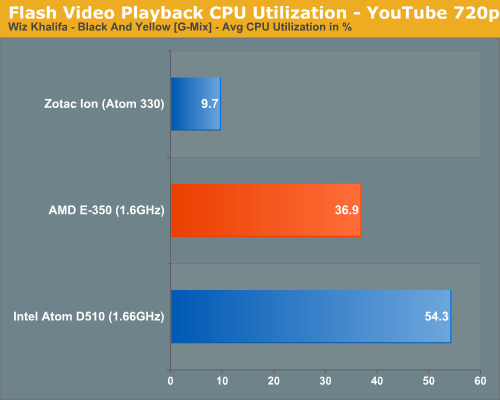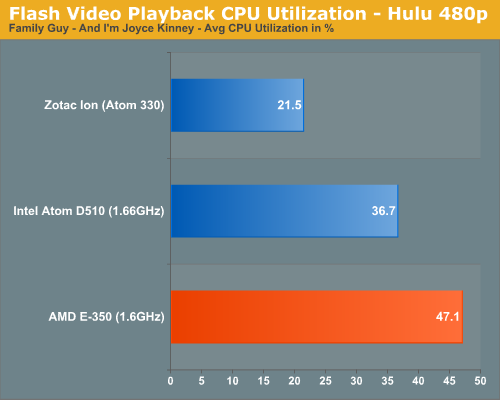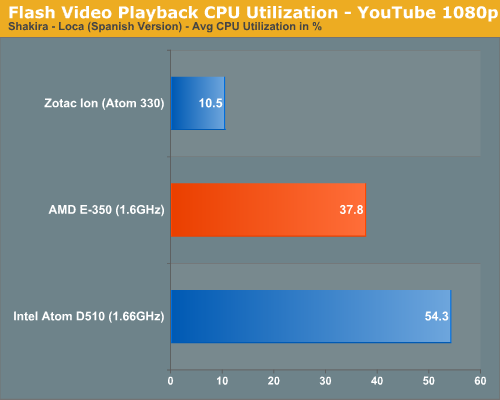The Brazos Review: AMD's E-350 Supplants ION for mini-ITX
by Anand Lal Shimpi on January 27, 2011 6:08 PM ESTBlu-ray & Flash Video Acceleration
Compatibility is obviously a strongpoint of Brazos. So long as what you’re decoding can be hardware accelerated you’re pretty much in the clear. But what about CPU utilization while playing back these hardware accelerated formats? The CPU still needs to feed data to the GPU, how many cycles are used in the process?
I fired up a few H.264/x264 tests to kick off the investigation. First we have a 1080p H.264 Blu-ray rip of Quantum of Solace, averaging around 15Mbps:
| Quantum of Solace 1080p H.264 CPU Utilization (1:00 - 1:30) | |||||
| Platform | Min | Avg | Max | ||
| AMD E-350 | 22.7% | 27.8% | 35.3% | ||
| Intel Atom D510 | Fail | ||||
| Zotac ION | 14.6% | 17.2% | 20.1% | ||
A standard Atom platform can’t decode the video but ION manages a 17% average CPU utilization with an Atom 330. Remember that the Atom 330 is a dual-core CPU with SMT (4-threads total) so you’re actually getting 17.2% of four hardware threads used, but 34.4% of two cores. The E-350 by comparison leaves 27.8% of its two cores in use during this test. Both systems have more than enough horsepower left over to do other things.
Next up is an actual Blu-ray disc (Casino Royale) but stripped of its DRM using AnyDVD HD and played back from a folder on the SSD:
| Casino Royale BD (no DRM) CPU Utilization (49:00 - 49:30) | |||||
| Platform | Min | Avg | Max | ||
| AMD E-350 | 28.1% | 33.0% | 38.4% | ||
| Intel Atom D510 | Fail | ||||
| Zotac ION | 17.7% | 22.5% | 27.5% | ||
Average CPU utilization here for the E-350 was 33% of two cores.
Finally I ran a full blown Blu-ray disc (Star Trek) bitstreaming TrueHD on the E-350 to give you an idea of what worst case scenario CPU utilization would be like on Brazos:
| Star Trek BD CPU Utilization (2:30 - 3:30) | |||||
| Platform | Min | Avg | Max | ||
| AMD E-350 | 29.0% | 40.1% | 57.1% | ||
At 40% CPU utilization on average there’s enough headroom to do something else while watching a high bitrate 1080p movie on Brazos. The GPU based video decode acceleration does work, however the limits here are clear. Brazos isn’t going to fare well as a platform you use for heavy multitasking while decoding video, even if the video decode is hardware accelerated. As a value/entry-level platform I doubt this needs much more explanation.
Now let’s talk about Flash.
I ran through a number of Flash video tests at both YouTube and Hulu ranging in resolution from 480p all the way up to 1080p. I used Flash 10.1, 10.2 beta as well as an unreleased version of 10.2 beta provided by AMD.


For the most part GPU accelerated Flash video does work well. Performance under both YouTube and Hulu was flawless, provided that I wasn’t watching 1080p content. Watching 1080p content in YouTube wasn’t entirely smooth on Brazos, despite posting very reasonable CPU utilization numbers.


I took my concerns to AMD and was told that this was a known issue with Brazos and Flash 10.1 and that 10.2 should alleviate the issue. AMD then supplied me with an unreleased version of Flash 10.2 to allow me to verify its claims. While 1080p playback improved with AMD’s 10.2 beta, it wasn’t perfect (although it was very close). AMD wouldn’t tell me the cause of the problem but it’s currently working on it with Adobe. At the end of the day I don’t believe it’s a dealbreaker, but early Brazos adapters should expect some stuttering when playing back 1080p YouTube videos. Note that 720p and lower resolution videos were perfectly smooth on Brazos.










176 Comments
View All Comments
tipoo - Thursday, January 27, 2011 - link
Goodbye, crappy Atom.ssj4Gogeta - Friday, February 4, 2011 - link
@Anand:"Remember that the Atom 330 is a dual-core CPU with SMT (4-threads total) so you’re actually getting 17.2% of four hardware threads used, but 34.4% of two cores."
Why would you say that, when those 4 threads are actually running on the 2 CPU cores? Or is it that the average for the 4 threads can never exceed 50%? Only in that case your doubling of the number makes sense.
ClagMaster - Thursday, January 27, 2011 - link
This is amazing performance for an 18W processor if you really think hard about it.This rig will beat my Athlon 1700+/KT266A/DDR-266/GeForce 4200 rig I had six years ago.
AMD will sell a lot of these Bobcats after the final bugs are worked out.
Dark_Archonis - Friday, January 28, 2011 - link
No, no it's not. Intel will very soon release 17W ULV Sandy Bridge CPUs.Even a current ULV Arrandale CPU will take out a Brazos in terms of CPU performance.
Kiijibari - Friday, January 28, 2011 - link
Hahaha ... attacking tiny Zacate with a Sandy Bridge ... yes it may have triple or quadruple performance, but so will be it's price ^^Shadowmaster625 - Friday, January 28, 2011 - link
yeah and the tray price will be $188 per cpu, in qty's of 1000. Haha good luck with that.djgandy - Friday, January 28, 2011 - link
Yes I am looking forward to ULV Sandybridge. I still have a Core Duo CULV which is starting to show its age. I'm sure it is still way faster than Atom and Zacate.It may cost more but you'll have 2-3 times the CPU performance with SB. Plus it should have dedicated video decode.
coconutboy - Friday, January 28, 2011 - link
You're only talking about the speed and if that's all you need, of course focus on a much pricier alternative. Now add in power envelope and price which is the entire point of this thing; moderate performance, very low power draw, dirt cheap. AMD nailed all of that.Brazos e-350 can be built as a tiny, passively cooled unit that costs a mere $100. If my neighbor asks me to build her a new system (again), this is EXACTLY what she'd want. It'll sit quiet 'n' cool in her living room right next to the TV and cost peanuts.
Toughest part of building a ~$200-250 Brazos rig will be getting an inexpensive (but not cheaply made), passively cooled PSU and case. RAM prices are barely a concern.
sebanab - Friday, January 28, 2011 - link
"you'll have 2-3 times the CPU performance with SB" -> the things i use notebooks for don't need allot of CPU.If you do allot of PI calculations / video encoding / SETI , well , you should get a job. And when you do get a job, you will also understand why a 500$ notebook is better than a 1K$.
I hope i don't annoy anyone , but Intel really has to pay for the four years of selling Atom saying "it is good enough".
knedle - Saturday, January 29, 2011 - link
I have a job and I'm running SETI (now it's called BOINC).When I have to make decision - get computer that will give me more SETI points, or computer that will give me more "money saved" points, I go for the money. :D